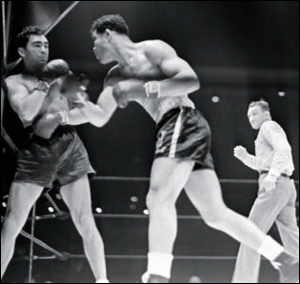86 years ago today, Joe Louis knocked out Max Schmeling in a re-match of perhaps the most famous fight series in history. It completely transcended the sport, as taking place in the months leading up to the Second World War, the fight between a black man born in Alabama versus a white German became a test on the highest stage for Hitler’s vision of Aryan supremacy. READ all about it… (1938)

The first fight between Louis and Schmeling took place on June 19th, 1936, at the famous Yankee Stadium in the Bronx, New York. The stadium’s seats were sold out. 57 million people listened on their radios. Schmeling handed Louis the first and only knockout loss of his career by effectively using his jab supported by a sneaky right cross behind it.
By the time of the Louis–Schmeling rematch in 1938, Nazi Germany had taken over Austria in the Anschluss. Schmeling enjoyed the national support, but distanced himself from the Nazis, saying “I’m a fighter, not a politician.”
The German regime nevertheless generated an onslaught of racially charged propaganda of its own; much of it created by propaganda minister Joseph Goebbels based on Schmeling’s success in the boxing world. Schmeling’s entourage also included an official Nazi Party publicist. The publicist not only controlled any possible contrarian remarks by Schmeling, but also issued statements that a black man could not defeat Schmeling, and that Schmeling’s purse from the fight would be used to build more German tanks.
A few weeks before the rematch, Louis visited President Franklin Delano Roosevelt at the White House. The New York Times quoted Roosevelt as telling the fighter, “Joe, we need muscles like yours to beat Germany.” Louis later wrote in his autobiography that he had to win for the whole country.
The second fight had 100 million people listening around the world, and in the words of Boxing commentator Teddy Atlas, it went like this.
“You had all this [pressure] and what does he do? He stalks Schmeling, and his punches were short and powerful.” After landing 5 left hooks and a body blow, the referee briefly intervened after Schmeling cried out in pain. Then during a quick resumption, Louis floored the German with a hook to the chin. Louis knocked him down two more times, and the referee stopped the fight.
MORE Good News on this Day:
- American aviator Wiley Post became the first person to fly solo around the world traveling 15,596 miles in 7 days and 18 hours and afterward received a ticker tape parade in New York City (1933)
- President Franklin Roosevelt signed the GI Bill of Rights, guaranteeing unemployment benefits and money for college for all US war veterans, making many of the 2.2 million returning soldiers the first in their families to get a college degree—see more below (1944)
- The voting age in the United States was lowered to 18 when President Richard Nixon signed the bill passed by Congress into law (1970)
- The Canadian House of Commons abolished capital punishment (1976)
- James “Whitey” Bulger, a longtime name on the FBI’s 10 Most Wanted list as a fugitive Boston crime boss, was arrested in Santa Monica, California (2011)
Garrison Keillor’s daily radio feature, Writer’s Almanac, reported on the success of FDR’s GI Bill of Rights: Before the war, about 10 percent of Americans attended college. After the war, that figure rose to about 50 percent. And contrary to most expectations, the grade-point averages at most colleges went up with the influx of veterans, and dropout rates went way down. Professors at the time said that the veterans were the most serious and disciplined students they’d ever seen. The cost to taxpayers of the GI Bill was about 5.5 billion dollars, but the result was 450,000 engineers, 240,000 accountants, 238,000 teachers, 91,000 scientists, 67,000 doctors, 22,000 dentists, 17,000 writers and editors, and thousands of other professionals. It helped spur one of the greatest economic booms in American history.
94 years ago today, famous Italian mountaineer and writer, Walter Bonatti, was born in Bergamo. Bonatti is one of the most famous Alpinists and climbed some of the most technically and physically challenging routes in Europe. In the 1950s, he began setting records, the first of which was the first successful summiting of Grand Capuchin, a tall red granite face in the Mont Blanc Group, followed up by the first winter ascent of the northern face of the westernmost peak in Le Tre Cime, or the three peaks of Lavaredo, in the Dolomites. He followed these later with the first-ever ascents of Gasherbrum IV in Pakistan, (7,925 meters (26,001 ft.) and of Rondoy Norte (5,789 meters (18,993 ft.), a remote peak of the Cordillera Huayhuash in Peru.

Selected as the Italian Alpine Club’s first team to attempt to climb K2, a scandal and disagreement among the team, which prevented the whole of them from reaching the summit, broke out in the aftermath and involved 50 years of vilification of Bonatti among Italian climbers. Extremely long story short, however, Bonatti was the victim of a conspiracy of lies and secrecy by two of the other climbers, and his consistency of evidence has exonerated him entirely.
In 1955, following the scandal, he became the first person to solo climb up the southwest pillar of the Aiguille du Dru in the Mont Blanc Group. In doing so he created a very exclusive group that will never accept new entries, as a landslide in 2011 destroyed the route. It requires six days and five hanging bivouacs and is considered a masterpiece of climbing.
After five days of climbing, Bonatti found himself stalled and faced with an impassable overhanging section. To the left and right the rock was absolutely smooth. Bonatti put together all the slings and small sections of ropes he had on him, attached one end of the rope in a crack, and swinging on the other end managed to negotiate the difficulty. This route, known afterwards as the Bonatti Pillar, is still considered today as one of the greatest achievements in Alpinism, never now to be repeated as long as men go into the mountains. (1930)
Happy 76h Birthday to the musical pioneer Todd Rundgren. After his chart-climbing hits as a singer-songwriter (Hello It’s Me, I Saw the Light, Bang on the Drum, and We Gotta’ Get You a Woman), the soulful Philadelphia crooner became a successful record producer (Patti Smith, Hall & Oates, Meat Loaf, the Psychedelic Furs, Tubes, New York Dolls, and XTC’s Skylarking, for example). After years of diversity in musical style and tech innovation, Todd will finally be inducted into the Rock and Roll Hall of Fame this October, 2021.

Touring and recording music continually since the 1960s (including with his band Utopia), Rundgren explored the cutting edge of video producing, interactive digital products, and fan-supported web portals. In 2017, he released the LP White Knight, featuring song collaborations with Trent Reznor, Daryl Hall, Joe Walsh, Donald Fagen, and Robyn.
WATCH him describe his inability to read music in this 2017 commencement speech at Berklee School of Music… (1948)
On this day 14 years ago, Rotary International wrapped up its four-year Kick Polio Out of Africa campaign, after contributing hundreds of millions of dollars and deploying countless volunteers. The effort eradicated 99% of the disease across the continent.

Nigeria, the last stronghold for the virus, finally reached three years without a case of wild polio last August, after Rotary using its website EndPolio.org had committed $268 million to the fight in that country, in partnership with the World Health Organization. (2010)

And, Happy Birthday to Meryl Streep who was born 75 years ago today in Summit, New Jersey. Often described as the best actress of her generation, Streep has been nominated for more Academy Awards than any other actor with a record 21 (she has won three). Holding her own in both comedies and dramas, she has a gift for mimicking accents, like her role as a Polish holocaust survivor in Sophie’s Choice (for which she won her second Oscar), and her portrayal of British Prime Minister Thatcher in The Iron Lady (for which she won her third). She won her first Oscar for Kramer vs. Kramer. This year, she joined the all-star cast on HBO’s television drama series Big Little Lies. (1949)
Streep’s Oscar-nominated films include in The Deer Hunter, The French Lieutenant’s Woman, Silkwood, Out of Africa, Ironweed, Evil Angels, Postcards from the Edge, The Bridges of Madison County, One True Thing, Music of the Heart, Adaptation, The Devil Wears Prada, Doubt, Julie & Julia, August: Osage County, Into the Woods, Florence Foster Jenkins, and The Post. WATCH a compilation of some of her greatest roles…
SHARE the Milestones, Memories, and Music…




















Awesome. Way to go FDR.